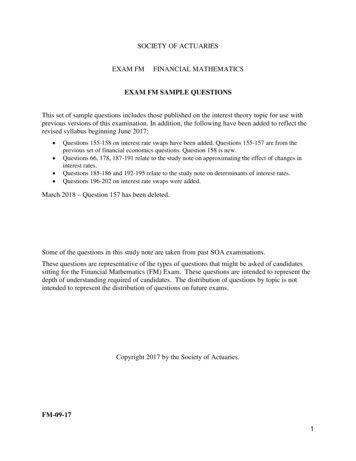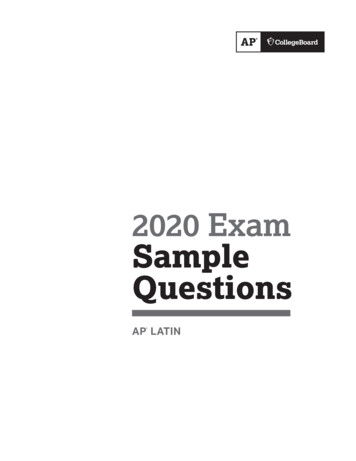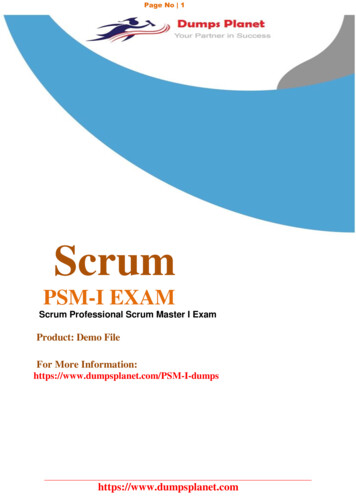
Transcription
SOCIETY OF ACTUARIESEXAM FMFINANCIAL MATHEMATICSEXAM FM SAMPLE QUESTIONSThis set of sample questions includes those published on the interest theory topic for use withprevious versions of this examination. In addition, the following have been added to reflect therevised syllabus beginning June 2017: Questions 155-158 on interest rate swaps have been added. Questions 155-157 are from theprevious set of financial economics questions. Question 158 is new.Questions 66, 178, 187-191 relate to the study note on approximating the effect of changes ininterest rates.Questions 185-186 and 192-195 relate to the study note on determinants of interest rates.Questions 196-202 on interest rate swaps were added.March 2018 – Question 157 has been deleted.Some of the questions in this study note are taken from past SOA examinations.These questions are representative of the types of questions that might be asked of candidatessitting for the Financial Mathematics (FM) Exam. These questions are intended to represent thedepth of understanding required of candidates. The distribution of questions by topic is notintended to represent the distribution of questions on future exams.Copyright 2017 by the Society of Actuaries.FM-09-171
1.Bruce deposits 100 into a bank account. His account is credited interest at an annual nominalrate of interest of 4% convertible semiannually.At the same time, Peter deposits 100 into a separate account. Peter’s account is credited interestat an annual force of interest of δ .After 7.25 years, the value of each account is the same.Calculate δ thryn deposits 100 into an account at the beginning of each 4-year period for 40 years. Theaccount credits interest at an annual effective interest rate of i.The accumulated amount in the account at the end of 40 years is X, which is 5 times theaccumulated amount in the account at the end of 20 years.Calculate X.(A)4695(B)5070(C)5445(D)5820(E)61952
3.Eric deposits 100 into a savings account at time 0, which pays interest at an annual nominal rateof i, compounded semiannually.Mike deposits 200 into a different savings account at time 0, which pays simple interest at anannual rate of i.Eric and Mike earn the same amount of interest during the last 6 months of the 8th year.Calculate i.(A)9.06%(B)9.26%(C)9.46%(D)9.66%(E)9.86%4.John borrows 10,000 for 10 years at an annual effective interest rate of 10%. He can repay thisloan using the amortization method with payments of 1,627.45 at the end of each year. Instead,John repays the 10,000 using a sinking fund that pays an annual effective interest rate of 14%.The deposits to the sinking fund are equal to 1,627.45 minus the interest on the loan and aremade at the end of each year for 10 years.Calculate the balance in the sinking fund immediately after repayment of the loan.(A)2,130(B)2,180(C)2,230(D)2,300(E)2,3703
5.An association had a fund balance of 75 on January 1 and 60 on December 31. At the end ofevery month during the year, the association deposited 10 from membership fees. There werewithdrawals of 5 on February 28, 25 on June 30, 80 on October 15, and 35 on October 31.Calculate the dollar-weighted (money-weighted) rate of return for the year.(A)9.0%(B)9.5%(C)10.0%(D)10.5%(E)11.0%6.A perpetuity costs 77.1 and makes end-of-year payments. The perpetuity pays 1 at the end ofyear 2, 2 at the end of year 3, ., n at the end of year (n 1). After year (n 1), the paymentsremain constant at n. The annual effective interest rate is 10.5%.Calculate n.(A)17(B)18(C)19(D)20(E)214
7.1000 is deposited into Fund X, which earns an annual effective rate of 6%. At the end of eachyear, the interest earned plus an additional 100 is withdrawn from the fund. At the end of thetenth year, the fund is depleted.The annual withdrawals of interest and principal are deposited into Fund Y, which earns anannual effective rate of 9%.Calculate the accumulated value of Fund Y at the end of year 10.8.(A)1519(B)1819(C)2085(D)2273(E)2431Deleted9.A 20-year loan of 1000 is repaid with payments at the end of each year.Each of the first ten payments equals 150% of the amount of interest due. Each of the last tenpayments is X.The lender charges interest at an annual effective rate of 10%.Calculate X.(A)32(B)57(C)70(D)97(E)1175
10.A 10,000 par value 10-year bond with 8% annual coupons is bought at a premium to yield anannual effective rate of 6%.Calculate the interest portion of the 7th coupon.(A)632(B)642(C)651(D)660(E)66711.A perpetuity-immediate pays 100 per year. Immediately after the fifth payment, the perpetuity isexchanged for a 25-year annuity-immediate that will pay X at the end of the first year. Eachsubsequent annual payment will be 8% greater than the preceding payment.The annual effective rate of interest is 8%.Calculate X.(A)54(B)64(C)74(D)84(E)946
12.Jeff deposits 10 into a fund today and 20 fifteen years later. Interest for the first 10 years iscredited at a nominal discount rate of d compounded quarterly, and thereafter at a nominalinterest rate of 6% compounded semiannually. The accumulated balance in the fund at the endof 30 years is 100.Calculate d.(A)4.33%(B)4.43%(C)4.53%(D)4.63%(E)4.73%13.Ernie makes deposits of 100 at time 0, and X at time 3. The fund grows at a force of interestt2δt , t 0.100The amount of interest earned from time 3 to time 6 is also X.Calculate X.(A)385(B)485(C)585(D)685(E)7857
14.Mike buys a perpetuity-immediate with varying annual payments. During the first 5 years, thepayment is constant and equal to 10. Beginning in year 6, the payments start to increase. Foryear 6 and all future years, the payment in that year is K% larger than the payment in the yearimmediately preceding that year, where K 9.2.At an annual effective interest rate of 9.2%, the perpetuity has a present value of 167.50.Calculate K.(A)4.0(B)4.2(C)4.4(D)4.6(E)4.815.A 10-year loan of 2000 is to be repaid with payments at the end of each year. It can be repaidunder the following two options:(i)Equal annual payments at an annual effective interest rate of 8.07%.(ii)Installments of 200 each year plus interest on the unpaid balance at an annualeffective interest rate of i.The sum of the payments under option (i) equals the sum of the payments under option (ii).Calculate i.(A)8.75%(B)9.00%(C)9.25%(D)9.50%(E)9.75%8
16.A loan is amortized over five years with monthly payments at an annual nominal interest rate of9% compounded monthly. The first payment is 1000 and is to be paid one month from the dateof the loan. Each succeeding monthly payment will be 2% lower than the prior payment.Calculate the outstanding loan balance immediately after the 40th payment is made.(A)6750(B)6890(C)6940(D)7030(E)734017.To accumulate 8000 at the end of 3n years, deposits of 98 are made at the end of each of the firstn years and 196 at the end of each of the next 2n years.2.0 .The annual effective rate of interest is i. You are given (1 i ) n Calculate i.(A)11.25%(B)11.75%(C)12.25%(D)12.75%(E)13.25%9
18.Olga buys a 5-year increasing annuity for X.Olga will receive 2 at the end of the first month, 4 at the end of the second month, and for eachmonth thereafter the payment increases by 2.The annual nominal interest rate is 9% convertible quarterly.Calculate X.(A)2680(B)2730(C)2780(D)2830(E)288010
19.You are given the following information about the activity in two different investment accounts:Account KFund valueDatebefore activityJanuary 1, 2014100.0July 1, 2014125.0October 1, 2014110.0December 31, 2014125.0ActivityDepositWithdrawalX2XAccount LFund valueDatebefore activityJanuary 1, 2014100.0July 1, 2014125.0December 31, 2014105.8ActivityDepositWithdrawalXDuring 2014, the dollar-weighted (money-weighted) return for investment account K equals thetime-weighted return for investment account L, which equals i.Calculate i.(A)10%(B)12%(C)15%(D)18%(E)20%11
20.David can receive one of the following two payment streams:(i)100 at time 0, 200 at time n years, and 300 at time 2n years(ii)600 at time 10 yearsAt an annual effective interest rate of i, the present values of the two streams are equal.Given v n 0.76 , calculate i.(A)3.5%(B)4.0%(C)4.5%(D)5.0%(E)5.5%21.Payments are made to an account at a continuous rate of (8k tk), where 0 t 10 .Interest is credited at a force of interest δ t 1.8 tAfter time 10, the account is worth 20,000.Calculate k.(A)111(B)116(C)121(D)126(E)13112
22.You have decided to invest in Bond X, an n-year bond with semi-annual coupons and thefollowing characteristics:(i)Par value is 1000.(ii)The ratio of the semi-annual coupon rate, r, to the desired semi-annual yield rate, i, is1.03125.(iii)The present value of the redemption value is 381.50.0.5889 , calculate the price of bond X.Given (1 i ) n (A)1019(B)1029(C)1050(D)1055(E)107223.Project P requires an investment of 4000 today. The investment pays 2000 one year from todayand 4000 two years from today.Project Q requires an investment of X two years from today. The investment pays 2000 todayand 4000 one year from today.The net present values of the two projects are equal at an annual effective interest rate of 10%.Calculate X.(A)5400(B)5420(C)5440(D)5460(E)548013
24.A 20-year loan of 20,000 may be repaid under the following two methods:(i)amortization method with equal annual payments at an annual effective interest rateof 6.5%(ii)sinking fund method in which the lender receives an annual effective interest rate of8% and the sinking fund earns an annual effective interest rate of jBoth methods require a payment of X to be made at the end of each year for 20 years.Calculate j.(A)6.4%(B)7.6%(C)8.8%(D)11.2%(E)14.2%25.A perpetuity-immediate pays X per year. Brian receives the first n payments, Colleen receivesthe next n payments, and a charity receives the remaining payments. Brian's share of the presentvalue of the original perpetuity is 40%, and the charity’s share is K.Calculate K.(A)24%(B)28%(C)32%(D)36%(E)40%14
26.Seth, Janice, and Lori each borrow 5000 for five years at an annual nominal interest rate of 12%,compounded semi-annually.Seth has interest accumulated over the five years and pays all the interest and principal in a lumpsum at the end of five years.Janice pays interest at the end of every six-month period as it accrues and the principal at the endof five years.Lori repays her loan with 10 level payments at the end of every six-month period.Calculate the total amount of interest paid on all three loans.(A)8718(B)8728(C)8738(D)8748(E)875827.Bruce and Robbie each open up new bank accounts at time 0. Bruce deposits 100 into his bankaccount, and Robbie deposits 50 into his. Each account earns the same annual effective interestrate.The amount of interest earned in Bruce's account during the 11th year is equal to X. The amountof interest earned in Robbie's account during the 17th year is also equal to X.Calculate X.(A)28.00(B)31.30(C)34.60(D)36.70(E)38.9015
28.Ron is repaying a loan with payments of 1 at the end of each year for n years. The annualeffective interest rate on the loan is i. The amount of interest paid in year t plus the amount ofprincipal repaid in year t 1 equals X.Determine which of the following is equal to X.(A)v n t1 i(B)v n t1 d(C)1 v n t i(D)1 v n t d(E)1 v n t29.At an annual effective interest rate of i, i 0%, the present value of a perpetuity paying 10 at theend of each 3-year period, with the first payment at the end of year 3, is 32.At the same annual effective rate of i, the present value of a perpetuity paying 1 at the end ofeach 4-month period, with first payment at the end of 4 months, is X.Calculate X.(A)31.6(B)32.6(C)33.6(D)34.6(E)35.616
30.As of 12/31/2013, an insurance company has a known obligation to pay 1,000,000 on12/31/2017. To fund this liability, the company immediately purchases 4-year 5% annualcoupon bonds totaling 822,703 of par value. The company anticipates reinvestment interest ratesto remain constant at 5% through 12/31/2017. The maturity value of the bond equals the parvalue.Consider two reinvestment interest rate movement scenarios effective 1/1/2014. Scenario A hasinterest rates drop by 0.5%. Scenario B has interest rates increase by 0.5%.Determine which of the following best describes the insurance company’s profit or (loss) as of12/31/2017 after the liability is paid.(A)Scenario A – 6,610, Scenario B – 11,150(B)Scenario A – (14,760), Scenario B – 14,420(C)Scenario A – (18,910), Scenario B – 19,190(D)Scenario A – (1,310), Scenario B – 1,320(E)Scenario A – 0, Scenario B – 031.An insurance company has an obligation to pay the medical costs for a claimant. Annual claimcosts today are 5000, and medical inflation is expected to be 7% per year. The claimant willreceive 20 payments.Claim payments are made at yearly intervals, with the first claim payment to be made one yearfrom today.Calculate the present value of the obligation using an annual effective interest rate of t be determined17
32.An investor pays 100,000 today for a 4-year investment that returns cash flows of 60,000 at theend of each of years 3 and 4. The cash flows can be reinvested at 4.0% per annum effective.Using an annual effective interest rate of 5.0%, calculate the net present value of this 2933.You are given the following information with respect to a bond:(i)par value: 1000(ii)term to maturity: 3 years(iii)annual coupon rate: 6% payable annuallyYou are also given that the one, two, and three year annual spot interest rates are 7%, 8%, and9% respectively.Calculate the value of the bond.(A)906(B)926(C)930(D)950(E)100018
34.You are given the following information with respect to a bond:(i)par value: 1000(ii)term to maturity: 3 years(iii)annual coupon rate: 6% payable annuallyYou are also given that the one, two, and three year annual spot interest r
EXAM FM SAMPLE QUESTIONS . This set of sample questions includes those published on the interest theory topic for use with previous versions of this examination. In addition, the following have been added to reflect the revised syllabus beginning June 2017: Questions 155-158 on interest rate swaps have been added. Questions 155-157 are from the previous set of financial economics











